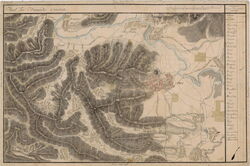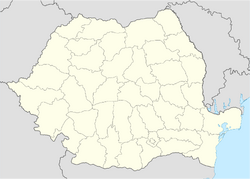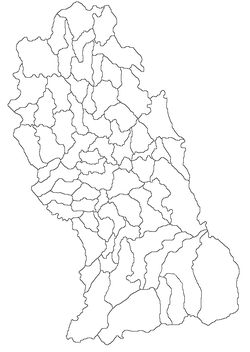| Main | Births etc |
|---|
| Deva Hungarian: Déva, German: Diemrich, Schlossberg, Denburg, Deva Latin: Sargetia |
|||
|---|---|---|---|
| — City — | |||
| Aerial view of Deva | |||
|
|||
| Coordinates: | |||
| Country | |||
| County | |||
| City | Deva | ||
| First mentioned | 1269 | ||
| Subordinated villages | List
|
||
| Government | |||
| • Mayor | Mircia Muntean (PSRO) | ||
| Area | |||
| • Total | 34.00 km2 (13.13 sq mi) | ||
| Elevation | 187 m (614 ft) | ||
| Population (2011) | |||
| • Total | 70 407 | ||
| • Density | 2,071/km2 (5,360/sq mi) | ||
| Time zone | EET (UTC+2) | ||
| • Summer (DST) | EEST (UTC+3) | ||
| Postal code | 330xxx | ||
| Phone area code | +40 a54 | ||
| Twin cities | |||
| • Arras | |||
| • Cherbourg-Octeville | |||
| • Szigetvár | |||
| • Yancheng | |||
| Website | www.primariadeva.ro | ||

Deva in the Josephinian Map of Transylvania, 1769-73
Deva (Hungarian: Déva, German: Diemrich, Schlossberg, Denburg, Deva; Latin: Sargetia)[1] is a city in Romania, in the historical region of Transylvania, on the left bank of the Mureș River. It is the capital of Hunedoara County.
The town includes the villages of Sântuhalm, and administers three villages Archia, Bârcea Mică and Cristur.
Name[]
Its name was first recorded in 1269 as castrum Dewa. The origin of the name gave rise to controversy. Some thought that the name is of old Turkic origin from the name Gyeücsa.[2] Others assert that the name is probably of Slavic origin where Deva or Devín means "girl" or "maiden".[3] A similar case exist in Slovak for the Devín Castle, located at the confluence of the Danube and Morava, on former town of Devín (now a suburb of Bratislava). It is also considered that the name comes from the ancient Dacian word dava, meaning "fortress" (as in Pelendava, Piroboridava, or Zargidava). Other theories trace the name to a Roman Legion, the Legio II Augusta, transferred to Deva from Castrum Deva, now Chester (Deva Victrix) in Britain.
On medieval maps Deva appears as: Dewan (first mention), Deva, or later Diemrich.
History[]
Documentary evidence of the city's existence first appeared in 1269 when Stephen V, King of Hungary and Duke of Transilvania, mentioned "the royal castle of Deva" in a privilege-grant for the Count Chyl of Kelling (Romanian: comitele Chyl din Câlnic).[4] Under Voivod John Hunyadi, Deva became an important military and administrative centre. Partially destroyed by the Ottoman Turks in 1550, it was afterward rebuilt and the fortress extended. In 1621 Prince Gabriel Bethlen transformed and extended the Magna Curia Palace (also known as the Bethlen Castle) in Renaissance style.
Geography[]
Deva is situated in the central part of Hunedoara County, on the left bank of the middle course of the Mureș River at 187 m above sea level.[5]
Demographics[]
According to the last census, from 2002, there were 69,257 people living within the city of Deva,[6] making it the 37th largest city in Romania. The ethnic makeup is as follows:
- Romanians: 89.21%
- Hungarians: 8.62%
- Gypsies: 1.26%
- Other: 0.91%
Economy[]
Automotive, commerce, construction materials and power industries are important to Deva's economy.
Education[]
A private University of Ecology and Tourism was established in the city in 1990, and the academic centres of Timişoara and Cluj-Napoca have opened branches in the city. Deva is also the home of Romania's national women gymnastics training centre.
Notable people[]
Deva is the birtplace of:
- François Bréda
- María Corda
- Matthias Dévay (1547), Protestant Reformer, referred to as the "Luther of Hungary"
- Bogdan Mara
- Dora Pavel
- Daniela Silivaş, medalist in Gymnastics at the 1988 Olympics
Climate[]
| Climate data for Deva | |||||||||||||
|---|---|---|---|---|---|---|---|---|---|---|---|---|---|
| Month | Jan | Feb | Mar | Apr | May | Jun | Jul | Aug | Sep | Oct | Nov | Dec | Year |
| Average high °C (°F) | 0.9 (33.6) |
4.7 (40.5) |
11.3 (52.3) |
17.0 (62.6) |
22.6 (72.7) |
24.3 (75.7) |
26.7 (80.1) |
26.7 (80.1) |
23.0 (73.4) |
17.0 (62.6) |
8.9 (48.0) |
3.0 (37.4) |
15.5 (59.9) |
| Average low °C (°F) | −5.9 (21.4) |
−3.2 (26.2) |
0.3 (32.5) |
4.6 (40.3) |
9.0 (48.2) |
12.0 (53.6) |
13.2 (55.8) |
12.8 (55.0) |
9.7 (49.5) |
4.6 (40.3) |
1.1 (34.0) |
−2.7 (27.1) |
4.6 (40.3) |
| Precipitation mm (inches) | 33.9 (1.335) |
28.1 (1.106) |
29.1 (1.146) |
50.0 (1.969) |
63.9 (2.516) |
79.8 (3.142) |
67.1 (2.642) |
56.1 (2.209) |
42.8 (1.685) |
37.5 (1.476) |
37.2 (1.465) |
39.5 (1.555) |
565.0 (22.244) |
| Source: Administrația Natională de Meteorologie[7][8] | |||||||||||||
Tourism[]
Deva is dominated by the Citadel Hill, a protected nature reserve because of its rare floral species and the presence of the horned adder. Perched on the top of the hill are the ruins of the Citadel built in the 13th century.
Twinned cities[]
 Arras, France
Arras, France Cherbourg-Octeville, France
Cherbourg-Octeville, FranceSzigetvar, Hungary
 Yancheng, China
Yancheng, China
Photo gallery[]
References[]
- ^ Fundaţia Jakabffy Elemér, Asociaţia Media Index, Attila M. Szabó. "Dicţionar de localităţi din Transilvania" (in romanian). http://dictionar.referinte.transindex.ro/index.php3?action=betu&betu=d&kezd=90&co=roman. Retrieved 2010-04-17.
- ^ János András Vistai. "Tekintő – Erdélyi Helynévkönyv". p. 236.Transylvanian Toponym Book (Hungarian)
- ^ Octavian, Floca (1969) (in romanian). Hunedoara ghid al judeţului. Deva. pp. 50. "Argumente de ordin lingvistic dovedesc că Deva îşi are originea într-un nume slav-sudic(Deva – fecioară)."
- ^ Octavian, Floca; Ben Bassa (1965) (in Romanian). Cetatea Deva. Monumentele patriei noastre. București: Editura Meridiane. pp. 14.
- ^ Octavian, Floca (1969) (in romanian). Hunedoara ghid al judeţului. Deva. pp. 50. "Deva, localitate de reşedinţă a judeţului Hunedoara, situată în stînga Mureşului, la poalele ultimelor ramificaţii dinspre nord ale munţilor Poiana Ruscăi, la înălţimea de 187 m deasupra mării, deşi este o localitate relativ mică, numărând 34982 (1968), este totuşi un oraş pitoresc, important centru administrativ şi cultural – animată aşezare pe cursul de mijloc al Mureşului."
- ^ "Ethno-demographic Structure of Romania". The Ethnocultural Diversity Resource Center. http://www.edrc.ro/recensamant.jsp?regiune_id=1832&judet_id=1987&localitate_id=1988. Retrieved 2 January 2011.
- ^ "Medii lunare multianuale 1961–1990" (in romanian). Administrația Natională de Meteorologie (Romanian National Administration of Meteorology). June 2011. http://www.meteoromania.ro/index.php?id=475. Retrieved 2010-04-22.
- ^ "Arhivă meteo" (in romanian). Administrația Natională de Meteorologie (Romanian National Administration of Meteorology). http://www.meteoromania.ro/index.php?id=124. Retrieved 2010-04-22.
| ||||||||

|
Vețel | Șoimuș | Hărău | 
|
| Cârjiți | Simeria | |||
 Deva | ||||
| Pestișu Mic | Hunedoara | Băcia |
| |||||||
| |||||||||||||
| This page uses content from the English language Wikipedia. The original content was at Deva, Romania. The list of authors can be seen in the page history. As with this Familypedia wiki, the content of Wikipedia is available under the Creative Commons License. |










